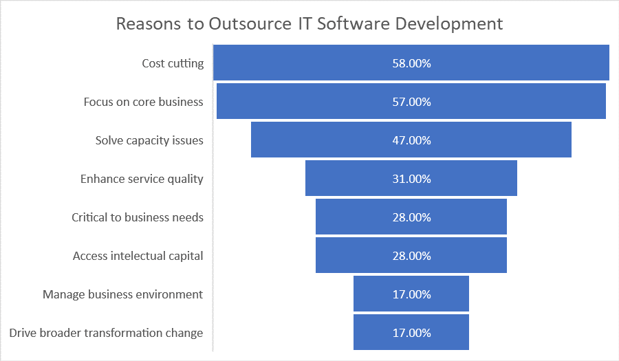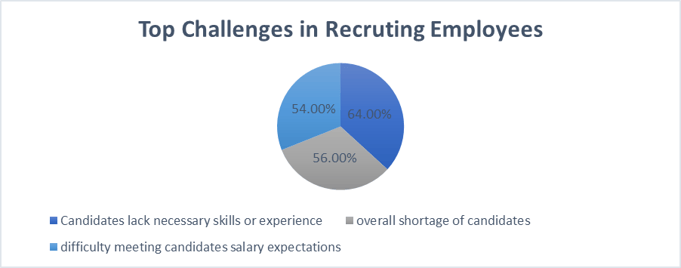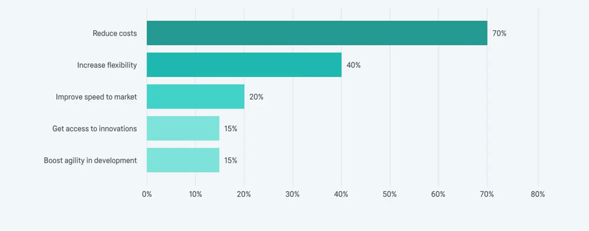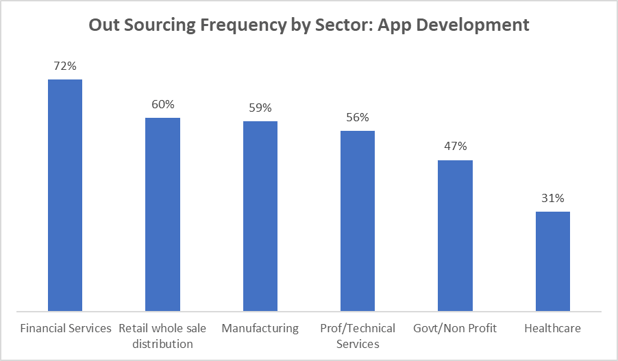The global IT outsourcing market is estimated to reach a valuation of USD 512.5 billion by 2024. Its revenue growth is expected to increase steadily at a rate of CAGR 10.99%, and the majority of revenue will be generated in the United States. Small startups, businesses, and large-scale organizations need IT outsourcing services to harness the full potential of talented professionals and cater to the growing demands of consumers and industries.
Approximately 63.5% of global IT outsourcing is comprised of three segments: administration, web hosting, and software development outsourcing. The increasing acceptance of remote work is fueling the expansion of the IT outsourcing market; companies are realizing that innovation and efficiency are critical to success.
Below, we will discuss some of the latest global IT outsourcing statistics for organizations in 2025.
Top Global IT Outsourcing Statistics in 2025
- The global IT outsourcing income is USD 92.5 billion, and the U.S. market earns up to USD 62 billion. 37% of IT operations in companies are being outsourced, and 13.6% of IT department budgets are allocated to outsourcing requirements.
- 45% of companies plan to increase their spending on IT outsourcing, and 90% will use cloud-based outsourcing solutions to connect remotely. Business Process Outsourcing (BPO) and Information Technology Outsourcing (ITO) are the top two sub-industries dominating this landscape.
- IT outsourcing encompasses mobile app development, data backup and recovery, cloud computing services, cybersecurity, and others. Deloitte estimates that global outsourcing spending might reach USD 132 billion.
- Web development is the most in-demand skill, and companies are looking for employees with sufficient AI, Machine Learning, and deep learning skills. The most active IT outsourcing hubs in the world are Poland and Ukraine; the total number of software developers has been steadily increasing and is expected to rise to 28.7 million in 2024.
- According to a recent Research and Markets report, the global IT outsourcing market is forecasted to grow at a CAGR of 5.54% and reach a market size of USD 904.9 billion by 2027. The growing adoption of virtualization has made hiring cost-effective outsourcing services popular among organizations. Outsourcing contracts target a minimum of 15% cost-savings, and in-house suppliers can generate substantial savings.
- A 2024 ManpowerGroup survey shows a significant shortage in hiring skilled talent, according to 75% of U.S. companies. Companies need individuals with specialized skills and don't want to invest in the long process of recruiting and finding talent. Outsourcing services can help them save time, find talent that is lacking in-house, and address global talent shortages.
- India is the world's outsourcing capital, and China is a significant player in the manufacturing industry. The Philippines and other Southeast Asian countries like Vietnam, Malaysia, and Thailand are supporting global IT outsourcing initiatives and attracting both regional and international clients.
- According to Gartner, 60% of IT outsourcing contracts are expected not to get renewed in the finance and accounting vertical. It is because of outdated pricing models that fail to accommodate process improvement and digitization.
- Data analysis reveals that mobile app outsourcing can help companies foster between 20% to 70% savings. Companies are improving their digital presence and streamlining customer journeys in today's digital era. Reports show that at least 21% of millennials launch mobile apps daily, and most users prefer in-app experiences over the web.
Key Global IT Outsourcing Trends
- Cloud-native outsourcing is rising, and businesses are leveraging cloud IaaS technologies to reduce infrastructure maintenance costs and maintain flexibility. IaaS services facilitate smooth collaboration among partners and teams working from anywhere, regardless of geographical boundaries. In 2024, cloud-based outsourcing solutions will enter the market and become prevalent. Organizations will use serverless computing and containerization technologies on the cloud to develop and deploy applications and projects and mitigate risks. A Deloitte report reveals an increasing trend towards using remote work models like Shared Services Centers (SSCs) and Global Business Services (GBS).
- With the advent of AI-powered threat detection and response systems, there has been an increased shift towards cyber security. Organizations are working to actively identify and neutralize threats in real time to prevent future data breaches. Cybersecurity AI is implementing measures to safeguard digital infrastructures and sensitive data and eliminate advanced persistent threats. Enterprises are adopting zero-trust security models as companies get busy implementing the principle of least-privilege access across multi-cloud environments and accounts.
- Nearshore software development is an emerging trend where companies turn to their regional markets to find the right project partners. It comes from a realization that not all outsourcing partners need to be hired overseas, and suitable matches can be found just a trip away. Building strong and reliable business partnerships is an integral component of IT outsourcing, and many companies are focusing on it.
- The Everything as a Service (XaaS) model is gaining popularity among the top global IT outsourcing trends. These models include everything businesses need to operate effectively, including products, tools, and services. There is an increasing emphasis on sustainable and ethical outsourcing (Green IT), and companies are recruiting talent committed to caring for the environment.
- AI-powered chatbots and intelligent automation are poised to redefine IT outsourcing practices and revolutionize customer service experiences. They will offer round-the-clock assistance, reduce operational costs, and use predictive analytics to enable businesses to identify and address potential issues. In 2024, Robotic Process Automation (RPA) will continue gaining traction, freeing up more time and resources and allowing organizations to focus on higher-value tasks and increase productivity.
- Companies will focus on improving their state of regulatory compliance. The introduction of stringent data protection standards like the California Consumer Privacy Act (CCPA), General Data Protection Regulation (GDPR), and more will profoundly impact global IT outsourcing services. Businesses will enhance customer data privacy, navigate complex data protection regulations, and adopt cutting-edge strategies to ensure continuous data security and compliance. Integrating AI and machine learning (ML) technologies will help identify real-time anomalies and enable them to respond to security incidents swiftly.
Strategic Imperatives: Decoding the Growth Trajectory of IT Outsourcing for Global Leaders
Outsourcing IT services empowers businesses to focus on core activities like product development and customer service, optimizing internal resources. By delegating software development to experts, companies can effectively cut costs, reallocating budgets to essential areas for growth. Moreover, outsourcing solves capacity issues, enabling swift scaling of development teams to meet deadlines without overwhelming in-house staff.
Experienced IT service providers enhance service quality, delivering high-quality products following industry best practices. Outsourcing becomes critical for businesses lacking in-house expertise for specific technical needs, ensuring alignment with business objectives.
Additionally, it provides access to global intellectual capital, fostering creative problem-solving and innovative solutions. By adapting swiftly to market demands and partnering with IT experts, businesses can drive broader transformative changes, staying competitive and responsive in dynamic environments.

1. IT Talent Shortage Unveiled: Strategies for Overcoming the Challenges
A comprehensive analysis of the IT talent shortage, its impact on technology sectors, and strategies for overcoming challenges and driving future investments.
The IT staffing shortages brought on by COVID-19 and the Great Resignation still affect companies today. In a poll of global tech leaders conducted by MIT Technology Review Insights 2023, 64% of respondents say candidates for their IT and tech jobs lack the necessary skills or experience. Another 56% cite an overall shortage of candidates as a concern.

MIT Technology Review Insights Poll, 2023
Understanding the IT Talent Shortage
The IT industry faces a severe shortage of qualified professionals. An aging workforce exacerbates this scarcity, a widening skill gap, and a lack of incentives in specific tech sectors.
Impact on Technology Adoption
Gartner's survey highlighted a significant hurdle IT firms face: a shortage of qualified workers hindering the adoption of new technology. This challenge was particularly prominent in IT automation, where 64% of emerging technology faced stagnation due to talent scarcity.
Amplifying Factors and Tech Sectors
A hiring boom, remote work trends, and accelerated technology adoption plans amplify the IT talent shortage. This scarcity is most acute in key tech sectors, including computing infrastructure, security, digital workplace, and IT automation. Investments in these areas have surged, with 58% of companies planning increased spending on emerging technologies.
Addressing Challenges and Future Investments
Organizations must focus on strategic hiring, upskilling programs, and targeted investments to bridge the talent gap. Resilience, especially in cloud technology, is a priority, focusing on ERP software and multi-cloud configurations. Additionally, increased investments in security measures are vital, with 64% of companies planning to enhance their security infrastructure.
2. Strategic Goals in IT Outsourcing: A Leadership Blueprint for Excellence
Leaders embark on a strategic journey with well-defined objectives in global IT outsourcing. These fundamental goals drive businesses to engage in outsourcing, emphasizing excellence in operational efficiency and market responsiveness.
Cost Efficiency:
Outsourcing significantly reduces operational costs by leveraging lower labor and infrastructure expenses in different regions, enabling businesses to allocate resources strategically and invest in other crucial growth areas.
Access to tools and practices: Global outsourcing provides a diverse talent pool with specialized skills, enabling businesses to collaborate with experts in various technologies and domains, ensuring high-quality software development and innovative solutions.
Scalability and Flexibility:
Outsourcing offers scalability, allowing businesses to quickly ramp up or downsize development teams based on project requirements. This flexibility ensures optimal resource utilization, making adapting to changing market demands and project scopes easier.
Speed to Market:
Outsourcing accelerates software development, reducing time-to-market. External expertise and streamlined workflows enable swift product launches, helping businesses stay competitive and capitalize on market opportunities.
Agility and Adaptability:
Outsourcing offers access to a diverse talent pool updated with industry trends. Businesses can quickly adapt to new technologies, market demands, and regulations, allowing them to pivot strategies, modify approaches, and stay relevant in the fast-changing business landscape.
Key Reasons why Companies Outsource:

3. Navigating Challenges: The Complexities of Global IT Outsourcing
Security and Data Privacy:
Ensuring data security and compliance with regulations demands robust cybersecurity measures to prevent breaches and unauthorized access.
Quality Control and Communication:
Maintaining consistent quality across distributed teams requires stringent quality control processes and efficient communication channels to address discrepancies promptly.
Cultural and Communication Barriers:
Bridging language and cultural gaps necessitates training, clear communication protocols, and fostering a collaborative atmosphere to enhance teamwork and minimize misunderstandings.
Legal and Regulatory Complexities:
Navigating diverse legal frameworks demands legal expertise to align agreements with international laws, mitigating potential legal risks in outsourcing.
|
Client's Success Story Clarion Technologies Delivered A Customized Mobile Application for A US-Based Realtor
|
4. Crafting a Roadmap: Diverse Models of IT Outsourcing for Every Need
Software development outsourcing involves companies delegating tasks to external providers. Various forms cater to specific needs.
Offshoring:
Offshoring involves outsourcing business processes or software development to a distant country, often with significant time zone differences. While it offers cost savings, managing communication challenges and potential cultural differences can be complex. Offshoring is ideal for tasks where continuous work progress is possible across different time zones.
|
Parameter |
Offshore |
Nearshore |
Onshore |
Freelancing/Remote |
|
Time to Get the Right Developers |
1 Day - 2 Weeks |
4 - 12 Weeks |
1 - 12 Weeks |
1 - 12 Weeks |
|
Time to Start a Project |
1 Day - 2 Weeks |
2 - 10 Weeks |
1 - 12 Weeks |
1 - 12 Weeks |
|
Recurring Cost of Training & Benefits |
0 |
Varied |
$10,000 - $30,000 |
0 |
|
Time to Scale Size of Team |
1 Day - 2 Weeks |
4 - 16 Weeks |
1 - 12 Weeks |
1 - 12 Weeks |
|
Pricing (Weekly Average) |
1.5X |
Varies |
4X |
1X |
|
Project Failure Risk |
Extremely low (98% success ratio) |
Low |
Low |
Very High |
|
Developers Backed by a Delivery Team |
Yes |
Some |
Some |
No |
5. Driving Excellence Across Industries: Global IT Outsourcing in Action
Global outsourcing in software development has become a strategic imperative for various industries.
- In the financial sector, institutions rely on outsourcing to fortify cybersecurity, ensuring seamless online transactions and bolstering customer trust.
- Retail businesses optimize their online presence, create user-friendly e-commerce platforms, and streamline supply chains, increasing sales and market competitiveness.
- Manufacturing companies leverage outsourced software solutions to enhance production processes and maintain high-quality standards, fostering operational excellence and innovation.
- Additionally, professional services firms enhance their efficiency through custom project management tools, focusing on client needs and strengthening their market reputation.

Image source - kruschecompany.com
Beyond business profitability, outsourcing plays a pivotal role in the public sector, enabling governments to deliver efficient public services through intuitive portals and streamlined data management systems. Non-profit organizations leverage cost-effective solutions, enhancing fundraising efforts and expanding their reach to support critical causes. In the healthcare domain, outsourcing facilitates the development of secure electronic health records and telemedicine applications, transforming patient care experiences and improving overall healthcare services.
By empowering organizations to concentrate on core competencies, global outsourcing fuels growth, fosters innovation, and delivers impactful, high-quality services across diverse sectors.
6. Global Insights: Geographical Distribution of IT Outsourcing:
Outsourcing activities in software development are geographically distributed across various regions worldwide. Several countries and regions are prominent outsourcing destinations due to factors like skilled workforce, infrastructure, and cost-effectiveness:
Asia-Pacific: Countries like India, China, the Philippines, and Vietnam are significant outsourcing hubs. India, in particular, is renowned for its large pool of skilled software developers and IT professionals.
Eastern Europe: Countries like Ukraine, Poland, and Romania are popular destinations for nearshore outsourcing. They offer skilled developers at competitive rates and are near Western European countries.
Latin America: Countries such as Brazil, Mexico, and Argentina are preferred for nearshore outsourcing by North American companies due to their cultural affinity and similar time zones.
North America and Western Europe: While these regions are often clients of outsourcing services, they also engage in onshore outsourcing within their countries to access specialized skills or manage peak workloads.
Understanding this geographical distribution is crucial for businesses seeking outsourcing partners, as it helps them make informed decisions based on factors such as time zone compatibility, cultural alignment, and cost-effectiveness.
|
|
Hourly Rates of Developers |
|||
|
Country |
Developer pool |
Junior |
Middle |
Senior |
|
India |
4,500,000 |
$15-20 |
$25-40 |
$50+ |
|
Singapore |
200,000 |
$20-25 |
$35-50 |
$55+ |
|
Indonesia |
-50,0000 |
$10-18 |
$20-30 |
$35+ |
|
Romania |
400,000 |
$15-23 |
$23-30 |
$45+ |
|
Poland |
139,000 |
$20-27 |
$35-50 |
$65+ |
|
Brazil |
500,000 |
$17-23 |
$25-35 |
$40+ |
|
Mexico |
1,000,000 |
$16-23 |
$23-30 |
$35+ |
Procoders. tech, daxx.com
7. Emerging Markets in IT Outsourcing:
Emerging markets, like Eastern Europe and Southeast Asia, are becoming prominent hubs for software development outsourcing due to their skilled talent pool and cost-effectiveness. Businesses are tapping into these regions to access specialized expertise and reduce operational expenses, driving a significant shift in the outsourcing landscape.
India: Known for its vast skilled workforce, cost-effectiveness, and fluent English-speaking developers, India remains a top choice for outsourcing software development, ensuring seamless communication and quality services.
China: With competitive labor costs and a large pool of IT specialists, China is a cost-effective option for companies seeking specific expertise, although language barriers can pose challenges in communication.
Vietnam: Emerging as a powerhouse, Vietnam offers a growing pool of IT experts and developers and low operating expenses. Language proficiency in English varies, making communication a consideration.
Romania: Boasting a diverse tech community, Romania's well-educated workforce and favorable time zones make it an attractive choice for Western European and North American companies. English proficiency is widespread.
Mexico: Ideal for client-facing tasks like customer service and marketing, Mexico offers a skilled workforce in a compatible time zone, providing cost-effective solutions for American companies.
7.1 Shifts in IT Outsourcing Destinations:
Traditional outsourcing destinations like India and China compete with newer players like Vietnam and Ukraine. This shift is fuelled by political stability, language proficiency, and cultural alignment. Companies are diversifying their outsourcing locations to mitigate risks and leverage unique skill sets, reflecting a dynamic global trend.
7.2 Region-wise Breakdown
Comparative Analysis of IT Outsourcing Costs in Software Development Across Regions
|
Number of Software Developers |
Annual IT Graduates |
Popular Programming Languages |
Average Hourly Rate ($) |
|
|
India |
5 million |
200,000 |
Java, PHP, ASP.NET, Ruby, API |
$18-$40 |
|
China |
5 million |
5 million |
Functional, Python, Shell, etc. |
$18-$40 |
|
Philippines |
95,000 |
130,000 |
Java, PHP, ASP.NET, Ruby, API |
$18-$40 |
|
Vietnam |
N/A |
20,000 |
Java, PHP, .NET, etc. |
$18-$32 |
|
Hungary |
80,000 |
6,000 |
Java, JS, SQL, C++, Shell |
$39-$52 |
|
Poland |
295,300 |
80,000 |
Python, Shell, Ruby, Java, PHP |
$40-$56 |
|
Romania |
125,000 |
5,000 |
C++, .NET, Java, PHP, JavaScript |
$25-$45 |
|
Ukraine |
200,000 |
36,800 |
C++, Java, Ruby, PHP, Python |
$25-$46 |
|
Bulgaria |
55,000 |
5,000 |
JavaScript, React, PHP, Java, SQL, Python |
$35-$50 |
|
Argentina |
134,000 |
N/A |
C, PHP, Java, JavaScript, .NET |
$30-$60 |
|
Brazil |
470,000 |
15,000 |
Java, Python, SQL |
$30-$50 |
8. Technological Advancements: Shaping the Future of IT Outsourcing:
Technological advancements, particularly AI and automation, are revolutionizing software development outsourcing. Automation tools streamline repetitive tasks, enhancing efficiency, while AI-driven analytics provide valuable insights. Outsourcing partners are integrating these technologies to offer faster, more accurate solutions, shaping a future where intelligent automation is integral to software development outsourcing processes.
8.1 Sustainability and Ethics in Outsourcing: A Paradigm Shift
Sustainability and ethics are gaining prominence in outsourcing decisions. Companies are scrutinizing outsourcing partners for eco-friendly practices and ethical labor standards. Social responsibility, fair wages, and environmentally conscious operations are becoming critical criteria. Businesses are opting for partners who align with their ethical values, reflecting a growing awareness of outsourcing practices' environmental and social impact.
|
Customer Success Story:
|
Future Horizons: Emerging Technologies Reshaping Outsourcing Strategies:
Artificial Intelligence (AI):
According to a report in 2023, Statista predicts the market size in the artificial intelligence market is projected to reach US$241.80 billion in 2023. The market size is expected to show an annual growth rate (CAGR 2023-2030) of 17.30%, resulting in a market volume of US$738.80 billion by 2030.
Chatbots, image-generating AI, and mobile applications are all major trends in improving AI in the coming years. In 2022, the release of ChatGPT 3.0 brought about a new awakening to the possibilities of generative artificial intelligence. A good understanding of this trend comes from observing the difference in interest in generative AI on Google, with interest increasing from 2022 to 2023. This interest is expected to continue as ChatGPT and others aim for updated chatbot versions in the future and further generative AI programs are being developed.
Cybersecurity:
According to Statista, Revenue in the cybersecurity market is projected to reach US$166.20 billion in 2023. Security Services dominates the market with a projected market volume of US$87.97 billion in 2023. Revenue is expected to show an annual growth rate (CAGR 2023-2028) of 10.48%, resulting in a market volume of US$273.60 billion by 2028.
Cybersecurity is a topic practically every company must tackle to ensure and enhance the success of the digital transformation of their operational activities (e.g., automated processes, cloud-based tools, or software support). The adoption of cybersecurity is expected to grow with the increasing internet penetration among developing and developed countries. While it was expected to dismiss cybersecurity as a task for the IT department, it is now increasingly becoming the dominant part of top-level strategic planning.
Low-code Development:
According to Statista, the global low-code platform market revenue is valued at almost 22.5 billion U.S. dollars in 2022 and is forecast to reach approximately 32 billion U.S. dollars in 2024. The market is projected to grow with a CAGR of 26.1 percent over this period.
IT operations occur in dynamic environments that demand rapid customization options in the software development process, which low-code development platforms seek to address. As a result, these platforms reduce time to market and backlogs, allowing businesses to realize value sooner at less cost. Retool, Zapier, and Airtable are among the leading low-code and no-code platforms for internal apps.
Progressive Web Applications (PWAs):
According to a current analysis by Emergent Research, the global progressive web application market is estimated to reach USD 10.44 Billion by 2027 at a CAGR of 31.9%.
Development of the latest and innovative technologies has resulted in a shift toward PWA, which allows users to access apps with the help of Uniform Resource Locators URLs. Large enterprises are rapidly adopting the PWA technology to accommodate those customers who do not want to install apps. Users are shifting toward the PWA technology to save storage space.
Cloud Services:
The inception of big data and the need to efficiently handle, access, and manage it drives the demand for cloud computing platforms/products and services. Additionally, with increasing dependency on IoT devices, data hosting on the cloud is inevitable, further propelling the demand for cloud computing.
Internet of Things (IoT):
According to Statista, the IoT market is expected to witness a significant surge in revenue, reaching a staggering US$1,177.00 billion worldwide by 2023.
Revolutionizing businesses by collecting data, expediting operations, and reducing operational expenses through interconnected sensors and gadgets. The growth of the Internet of Things market coincides with the development of other essential technologies, such as 5G and cloud computing. The deployment of 5G communication standards paves the way for a faster and smoother connection among smart devices.
Mixed Reality:
According to Statista, This statistic shows the mixed reality market size worldwide in 2017, 2018, and 2025. It is estimated that over this period, the market will increase from roughly 47 million to about 3.7 billion U.S. dollars.
Fusion of reality and virtual worlds, creating immersive environments with applications in industries like real estate and restaurants, enhancing interactive business experiences. Today's mixed reality hardware targets businesses primarily for manufacturing, warehousing, training education, and construction applications.
Why Choose Clarion Technologies as Your Outsourcing Partner:
- Dedicated Project Manager: Assigned regardless of team size, ensuring expertise in managing diverse business models.
- vEmployee Model: More than a vendor, Clarion is your partner in success, offering the best of both worlds - quality and cost-efficiency.
- Top 5% Talent: Access world-class professionals with a low attrition rate, ensuring high-quality development teams.
- Maximized Output: Benefit from a free supervisor, quality auditor, and service delivery manager to enhance productivity.
- Flexible Resource Management: Easily ramp up or ramp down resources based on your business needs, providing optimal control.
Other Factors to Consider
Hiring the right outsourcing vendor is more about finding the right professionals who align with your company's mission and vision. It's important to hire talent suited to your specific industry instead of looking for popular talent.
Clear, straightforward communication and transparency are a must. Companies must find partners that can navigate technological complexities and help them make the right business decisions. Sometimes, pricing can get expensive, but investing in the right talent long-term is worth it. An individual who is an expert at project management and takes a bird's eye view of tracking and managing operations can help run things along smoothly.
Conclusion:
The top global IT outsourcing statistics reveal that IT outsourcing arrangements will become more flexible and adopt a more nuanced approach. Organizations will push for outcome-based pricing models, shorter contract terms, and robust security measures that align with the best data protection regulations to ensure quality services to clients.
As remote work becomes the norm, companies will turn to IT outsourcing support and cloud service and use collaboration tools to perform various tasks. AI and automation will play a pivotal role in organizations and help them become more resilient and competitive in 2024. There are many uncertainties businesses will have to navigate during these changing times as well; however, by focusing on innovation, cost-effectiveness, and clients' well-being, they will get ahead and continue to grow.
If you need assistance finding the right talent, Clarion Technologies can help you get started. We build offshore technology teams quickly and offer top IT service delivery to match every business's needs. Hire top developers in India and the U.S. today and work with experienced developers who provide fast turnaround times. Our IT outsourcing professionals are well-versed with the latest technologies such as .NET, JAVA, Python, Laravel, DevOps, Angular, and other frameworks. We provide a 2-week risk-free trial, and our offshore development team will contact you within 48 hours after you submit your first inquiry.
Author




